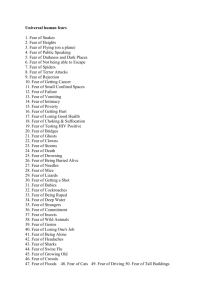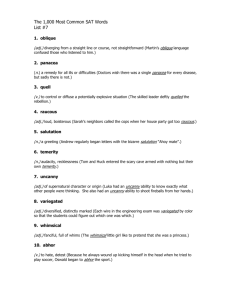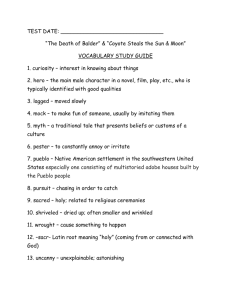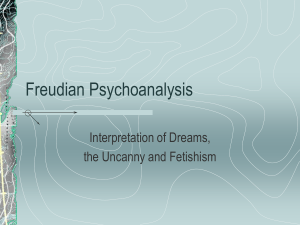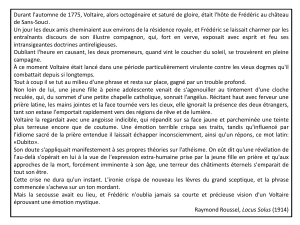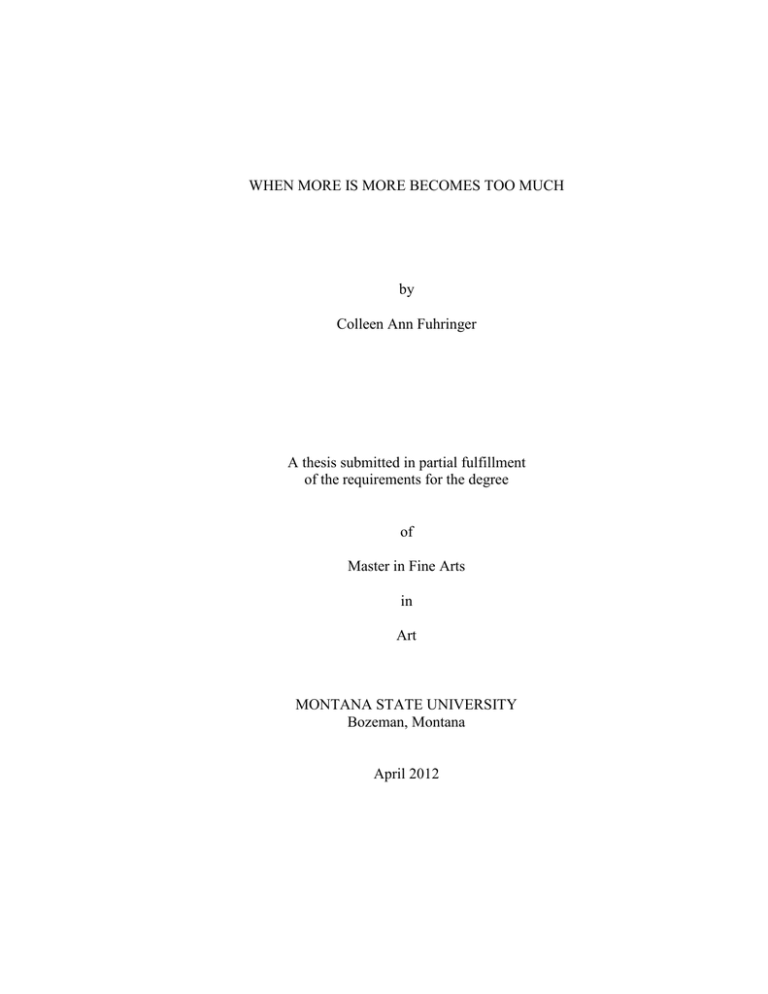
WHEN MORE IS MORE BECOMES TOO MUCH
by
Colleen Ann Fuhringer
A thesis submitted in partial fulfillment
of the requirements for the degree
of
Master in Fine Arts
in
Art
MONTANA STATE UNIVERSITY
Bozeman, Montana
April 2012
©COPYRIGHT
by
Colleen Ann Fuhringer
2012
All Rights Reserved
ii
APPROVAL
of a thesis submitted by
Colleen Ann Fuhringer
This thesis has been read by each member of the thesis committee and has been
found to be satisfactory regarding content, English usage, format, citation, bibliographic
style, and consistency and is ready for submission to The Graduate School.
Rollin Beamish
Approved for the School of Art
Vaughan Judge
Approved for The Graduate School
Dr. Carl A. Fox
iii
STATEMENT OF PERMISSION TO USE
In presenting this thesis in partial fulfillment of the requirements for a master’s
degree at Montana State University, I agree that the Library shall make it available to
borrowers under rules of the Library.
If I have indicated my intention to copyright this thesis by including a copyright
notice page, copying is allowable only for scholarly purposes, consistent with “fair use”
as prescribed in the U.S. Copyright Law. Requests for permission for extended quotation
from or reproduction of this thesis in whole or in parts may be granted only by the
copyright holder.
Colleen Ann Fuhringer
April 2012
iv
LIST OF IMAGES
Image
Page
1. The Fairest One of All, 2012, latex paint, artificial sinew, tulle, vintage mirror...........10
2. The Fairest One of All (detail) .......................................................................................11
3. The Fairest One of All (installation detail) ....................................................................11
4. Take Matters Into Your Own Hands, 2012, latex paint .................................................12
acrylic, paper, artificial sinew, fabric, foam, found objects, vintage furniture
5. Take Matters Into Your Own Hands (detail) .................................................................13
6. Take Matters Into Your Own Hands (detail) .................................................................13
7. Take Matters Into Your Own Hands (detail) .................................................................14
8. Take Matters Into Your Own Hands (installation detail) ..............................................14
9. Transform Me Into What You Like, 2012 .....................................................................15
latex paint, gelatin, glass, found objects
10. Transform Me Into What You Like (detail) ................................................................16
11. Transform Me Into What You Like (detail) ................................................................16
12. Transform Me Into What You Like (detail) ................................................................17
13. Transform Me Into What You Like (installation detail)..............................................17
14. When More is More Becomes Too Much, 2012..........................................................18
fabric, twine, gelatin, found objects, vintage furniture
15. When More is More Becomes Too Much (detail) .......................................................19
16. When More is More Becomes Too Much (detail) .......................................................20
17. When More is More Becomes Too Much (detail) .......................................................21
v
LIST OF IMAGES – CONTINUED
Image
Page
18. When More is More Becomes Too Much (detail) .......................................................22
19. When More is More Becomes Too Much (detail) .......................................................23
20. When More is More Becomes Too Much (detail) .......................................................23
21. When More is More Becomes Too Much (installation detail) ....................................24
22. When More is More Becomes Too Much (installation detail) ....................................25
23. When More is More Becomes Too Much (installation detail) ....................................25
24. What May Be Difficult to Grasp, 2012........................................................................26
steel tongs, combine elevator chain, nylon stockings
25. What May Be Difficult to Grasp (detail) .....................................................................27
26. Turned On and No One’s Home, 2012 ........................................................................27
latex paint, acrylic, paper, artificial sinew, tulle, found objects, vintage furniture
27. Turned On and No One’s Home (detail)......................................................................28
28. Turned On and No One’s Home (detail)......................................................................28
29. Turned On and No One’s Home (installation detail) ...................................................29
30. Turned On and No One’s Home (detail)......................................................................29
31. The Fairest One of All (installation detail) ..................................................................30
vi
ABSTRACT
Though we live in an age of uncertainty, we are constantly surrounded by what is
predictable and routine. What happens when the comfort of our understanding is
questioned? This body of work developed out of my experimental curiosity and desire to
merge the familiar with the unexpected. Incorporating furniture and found objects brings
a level of familiarity to the viewer, but manipulating the usual and adding strange
elements causes inquiry. All of the components are set up into narrative tableaus and
every part is considerably important to the whole. The installation explores humor and
fear related to the grotesque and the uncanny, exploring contradictory elements such as:
anthropomorphic and foreign, vibrant and static, seductive and repulsive. Each scene
reveals no answers but poses only questions, inviting the viewer to fully experience their
surroundings and come up with their own conclusions. We often exist between the
margins of the known and the unknown but our understanding of this existence is purely
individual.
1
Though we live in an age of uncertainty, we are constantly surrounded by what is
predictable and routine. What happens when the comfort of our understanding is
questioned? This body of work developed out of my experimental curiosity and desire to
merge the familiar with the unexpected. Incorporating furniture and found objects brings
a level of familiarity to the viewer, but manipulating the usual and adding strange
elements causes inquiry. All of these components are set up into narrative tableaus and
every part is considerably important to the whole. Each scene reveals no answers but
poses only questions, inviting the viewer to fully experience their surroundings and come
up with their own conclusions.
Within the narratives, the relationships between the pieces create a balance of
contradictions, such as: anthropomorphic and foreign, vibrant and static, seductive and
repulsive. This balance is the middle ground, the in-between nature that can best be
described as “grotesque.” The true definition of the grotesque lies far beyond what is
considered disgusting and repulsive. It is recognizing the importance of contradiction
and the undeniable presence of the unknown. As described by Geoffrey Galt Harpham in
his book On the Grotesque: Strategies of Contradiction in Art and Literature (1982):
When we use the word “grotesque” we record, among other things,
the sense that though our attention has been arrested, our
understanding is unsatisfied. Grotesqueries both require and defeat
definition: they are neither so regular and rhythmical that they
settle easily into our categories, nor so unprecedented that we do
not recognize them at all. They stand at a margin of consciousness
between the known and the unknown, the perceived and the
unperceived, calling into question the adequacy of our ways of
organizing the world, of dividing the continuum of experience into
knowable particles. (Harpham 3)
2
On the basis of stored knowledge, our thought processes are able to turn in specific
directions. But when confronted with unknown elements, those thought processes are
suddenly confused. Multiple meanings and interpretations exist but no single answer
may be found. One is left with their own imagination to try, or try not, to make sense of
it all.
It could be said that within this margin of uncertainty there exists no definition, no
words fitting to describe. Perhaps the word grotesque “accommodates the things left over
when the categories of language are exhausted.” (Harpham 3) In that case, even the word
grotesque is contradictory, a description to the indescribable. In his essay for the fifth
international SITE Santa Fe Biennial (July 18, 2004 – January 9, 2005), curator Robert
Storr introduces his writing on the grotesque with the idea of corruption of language. As
stated by Storr:
“The assumption is that words say what they mean but must be
kept under watch for fear that they might express something
slightly more, slightly other than, or even something contrary to
what we intend… Thus, we aspire to absolute clarity but live with
ambiguity.” (Storr 10)
There are many who seek answers to all questions, who are frightened by the thought of
living with uncertainty. After all, the purpose of language is to communicate and to
explain. But what happens when language fails itself? Then we are left with sensation.
Often there are experiences to which words do no justice. When descriptions
become “sort of like” something else that is relatable. There is power in leaving language
behind. Without the worry of putting words to an event, one is left only to feel. Words
are fleeting and physical resonance can be much more powerful. With my work, I invite
the experience to go beyond visual. The senses of touch and smell heighten awareness
3
and leave more of an impact on the viewer. This type of encounter is based on multiple
senses and becomes very difficult to fully put into words. It is the “left over” area that
Harpham describes, that which holds combinations of contradictions.
While contradictory experience and sensation can be described as grotesque, the
term “uncanny” is closely related. First undertaken by Dr. Ernst Jentsch in his essay On
the Psychology of the Uncanny (1906), the word uncanny “suggests that a lack of
orientation is bound up with the impression of the uncanniness of a thing or incident.”
(Jentsch 2) Lack of familiarity with one’s surroundings can result in the uncanny.
However, as Jentsch states “the same impression does not necessarily exert an uncanny
effect on everybody.” (Jentsch 2) With each daily occurrence, the individual brings with
them their own past experience and personal memory. Response to each occurrence is
directly related to this experience and memory. The same goes with viewing a work of
art. While similarities exist within the basic knowledge of a culture, causing many to
have a response that is somewhat alike, no two personal experiences will be identical.
As Jentsch attempts to come closer to the essence of the uncanny, he speaks of
our desire to make connections, “the intellectual mastery of the new thing.” (Jentsch 4)
Even in our age of technology, there are things that cannot be explained. We often
discount the unexplainable or try to rationalize to the best of our abilities. What if
something is best described as odd or strange? Making connections is human nature but
there are many instances where conceptual connections will never be complete. Jentsch
goes on to describe the familiar “not only as welcome, but – however remarkable and
inexplicable it may be – as straightforwardly self-evident.” (Jentsch 4) Objects and
4
events of the everyday become so commonplace that their true appearance is often
overlooked. We become conditioned by repetition. Simply changing one’s perception of
the usual can result in the uncanny. The gallery space is the perfect opportunity for this.
Removing objects, such as furniture, from their regular environments and placing them
within the white cube of the gallery automatically changes the context, thus increasing
the possibility of an uncanny occurrence.
While Jentsch’s essay was well received, perhaps the most popular writing on the
subject of the uncanny has come from Sigmund Freud. In his essay The Uncanny (1919),
Freud uses Jentsch’s writing as largely the basis for further research. While Jentsch
connects feelings of the uncanny with lack of orientation, Freud says the uncanny
“belongs to the realm of the frightening, of what evokes fear and dread.” (Freud 123)
Freud goes on to say: “It is equally beyond doubt that the word is not always used in a
clearly definable sense, and so it commonly merges with what arouses fear in general.”
(Freud 123) Being uncertain about one’s surroundings can certainly cause fear, but
where Jentsch is more concerned about disorientation, Freud stresses the aspect of fear.
Along with one’s surroundings, being uncertain about anything can be fearful. It is
characteristically human to want to figure things out and have an answer and a place for
everything. As we search for answers, there is definitely a place for fear of the unknown.
Both Jentsch and Freud speak of the German word “unheimlich” as being closely
related to the evolution of the word uncanny. While “heimlich” is ‘belonging to the
house, not strange, familiar, tame, dear and intimate, homely, etc.’ then unheimlich
would be the opposite. Freud describes the uncanny as “that species of the frightening
5
that goes back to what was once well known and had long been familiar.” (Freud 124) In
Freud’s research, what were once heimlich surroundings had been repressed only to
reappear in a frightening manner. The passing of time would be the catalyst for
repression of what were once familiar surroundings. There are even more opportunities
for this type of uncanny experience to occur in the present day. With our visual culture,
computers, movies and television are constantly in our line of sight. Many of these
visuals, such as a particularly powerful movie scene, stay with us only to lessen as time
goes on. While real life experience holds the most strength in repression and
reemergence as the uncanny, other types of visual material have the ability to resurface
given the opportunity.
The grotesque and the uncanny have a close relation. Both concepts delve heavily
into unknown territory, leaving the imagination of the subject to reach individual
conclusions. These potential conclusions, or rationalizations, can only be met with
access to memory and personal experience. This unknown territory is Harpham’s
description of the grotesque as being “at a margin of consciousness between the known
and the unknown.” (Harpham 3) Also for an experience to be uncanny, one must
recognize the familiar elements through access to personal memory. While the unknown
part of the uncanny directly relates to Jentsch’s lack of orientation, Freud pushes the idea
further with repression of memory. There is a push-pull that happens with an uncanny
incident. While one feels out of their element (disorientation), there is that strange
familiarity (repression of memory) that brings one back. A related description is the
seductive and repulsive mechanism that directly correlates with the grotesque.
6
With this installation, my intention is to access those sensations of the grotesque
and the uncanny within the viewer. The narratives of “When More is More Becomes Too
Much” contain the familiar and the unfamiliar, to each tell a story that falls in the margin
of consciousness between the known and the unknown. The objects of everyday life
bring a level of familiarity to the viewer, but they are composed and altered in such a way
that is not customary. Taking these things out of their normal environment shifts the
context immediately, and the interaction between reality and abstraction pushes the
boundaries of the setting even further. Often we take for granted the predictability of our
situations and choose to ignore what is out of our comfort zone. But a monotonous
environment hinders growth and imagination while supporting stagnation. Examining a
range of possibilities will access past experience and memory within the mind. Letting
go of control and accepting the vulnerability of our existence will access those memories
that are fully repressed.
To be mentally and emotionally vulnerable can also expose that side to our
physicality. When the logical assessment tools of the brain fail, we resort to explanations
based on the many sensations felt in the body. As Geoffrey Galt Harpham states, “the
sense of the grotesque arises with the perception that something is illegitimately in
something else.” (Harpham 11) Combining elements not typically found together causes
a co-presence that can be imagined within the body, especially when some of the
components relate to the human form. Inanimate objects become people with individual
personalities when swelled into shapes reminiscent of human forms. Flexible latex skins
cover or protrude out of normally tame household items. Combinations such as these
7
have potential to seduce the witness through texture and slight familiarity, but at the same
time repulse with the thought of invasion in their own body.
In all of the narratives, the underlying humor is an important part. But along with
this humor there is an element of fear and these two contradictory feelings lie on opposite
sides of the spectrum. They both have the ability to heighten the awareness of the other
through a push-pull experience similar to what is uncanny. While humor tends to relax
the viewer, an inclination of fear causes tension. For example, to imagine a chair
becoming human is ludicrous; to imagine oneself pulled in and transformed into a lifeless
inanimate object is terrifying. This type of contradictory situation brings together
understanding, disbelief and astonishment, and bounces the viewer back and forth
between their surroundings seeming heimlich and unheimlich. While it is human nature
to fear what has no explanation, it is also important to ask why those feelings occur.
In his essay on the grotesque, Robert Storr goes on to mention “one might
reasonably conclude that the present era is somehow inherently grotesque. I will not
dispute that, except to note that in Dickensian logic the best of times is always
accompanied by the worst.” (Storr 12) Following the notion of Dickensian logic, all of
the marvels and advancements of modern technology receive a direct counterpoint with
the broadcast of fear and mass destruction. But this logic can also make its way into
everyday life. We seek safety and comfort but yearn for exhilarating experiences to
make us feel more alive. The grotesque and uncanny can lead the imagination to
undiscovered territory, and potentially hold answers to questions unknown. Whether one
is delving into unknown territory on a quest for answers or searching for meaning within
8
a grotesque narrative, the interpretation is subject to memory and personal experience.
We often exist between the margins of the known and the unknown but our
understanding of this existence is purely individual.
9
Works Cited
Freud, Sigmund. The Uncanny. New York: Penguin Group, 2003.
Harpham, Geoffrey Galt. On the Grotesque: Strategies of Contradiction in Art and
Literature. Princeton University Press: Princeton, New Jersey, 1982.
Jentsch, Ernst. On the Psychology of the Uncanny (1906). Translated by Roy Sellars.
http://www.art3idea.psu.edu/locus/Jentsch_uncanny.pdf
Storr, Robert. Disparities & Deformations: Our Grotesque. The Fifth International Site
Santa Fe Biennial: July 18, 2004 – January 9, 2005. New York: Distributed Art
Publishers, 2004.
10
11
Image 1 – The Fairest One of All
Image 2 – The Fairest One of All (detail)
12
Image 3 – The Fairest One of All (installation detail)
13
Image 4 – Take Matters Into Your Own Hands
Image 5 – Take Matters Into Your Own Hands (detail)
14
Image 6 – Take Matters Into Your Own Hands (detail)
Image 7 – Take Matters Into Your Own Hands (detail)
15
Image 8 – Take Matters Into Your Own Hands (installation detail)
16
Image 9 – Transform Me Into What You Like
Image 10 – Transform Me Into What You Like (detail)
17
Image 11 – Transform Me Into What You Like (detail)
Image 12 – Transform Me Into What You Like (detail)
18
Image 13 – Transform Me Into What You Like (installation detail)
19
Image 14 – When More is More Becomes Too Much
Image 15 – When More is More Becomes Too Much (detail)
20
21
Image 16 – When More is More Becomes Too Much (detail)
22
Image 17 – When More is More Becomes Too Much (detail)
Image 18 – When More is More Becomes Too Much (detail)
23
Image 19 – When More is More Becomes Too Much (detail)
24
Image 20 – When More is More Becomes Too Much (detail)
25
Image 21 – When More is More Becomes Too Much (installation detail)
Image 22 – When More is More Becomes Too Much (installation detail)
26
Image 23 – When More is More Becomes Too Much (installation detail)
27
Image 24 – What May Be Difficult to Grasp
Image 25 – What May Be Difficult to Grasp (detail)
28
Image 26 – Turned On and No One’s Home
Image 27 – Turned On and No One’s Home (detail)
29
Image 28 – Turned On and No One’s Home (detail)
Image 29 – Turned On and No One’s Home (installation detail)
30
Image 30 – Turned On and No One’s Home (detail)
Image 31 – The Fairest One of All (installation detail)

